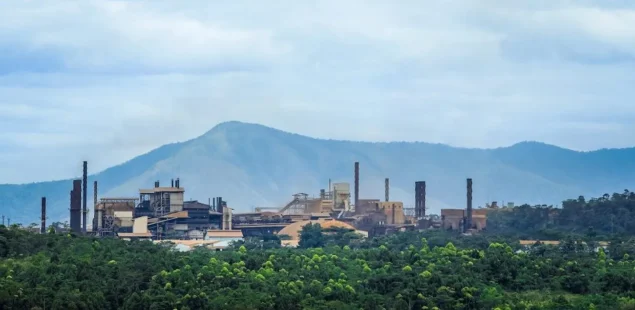
Eurasian Resources Group, a Kazakhstan-based mining conglomerate with operations across Africa and Central Asia, plans to invest $20 million in gallium production facilities that would position Kazakhstan as the world’s second-largest producer of the critical semiconductor metal after China. The company will extract gallium from bauxite ore waste streams at its existing alumina operations, targeting 15 tonnes of annual production capacity by 2026 to serve OECD markets amid growing supply chain security concerns following China’s export restrictions to the United States.
Strategic Timing Capitalizes on Supply Chain Disruption
ERG’s gallium initiative launches as global markets grapple with China’s December 2024 export ban on gallium, germanium, and antimony to the United States, implemented in response to Washington’s semiconductor industry sanctions. China controls approximately 99% of global primary gallium production, creating acute supply vulnerabilities for Western technology and defense sectors that rely on gallium arsenide and gallium nitride semiconductors for 5G networks, military radar systems, and electric vehicle power electronics.
The US Geological Survey estimates that a complete cessation of Chinese gallium exports could reduce American GDP by $3.4 billion while triggering price increases of 150% for gallium and constraining supply across critical technology sectors. ERG’s planned 15-tonne annual capacity represents approximately 2% of global production but would provide meaningful supply diversification for Western markets seeking alternatives to Chinese sources.
Market Dynamics Drive Critical Minerals Investment
Global gallium demand has accelerated dramatically, with market valuations projected to expand from $3.7 billion in 2025 to $17.0 billion by 2032 at a compound annual growth rate of 24.5%. This expansion reflects surging demand from semiconductor manufacturing, particularly gallium nitride components essential for 5G telecommunications infrastructure, artificial intelligence computing systems, and electric vehicle power management systems.
Current global production totals approximately 760 tonnes annually, with China accounting for the vast majority through byproduct recovery from aluminum smelting operations. Japan, South Korea, and Russia contribute minimal quantities, while Germany, Hungary, and Kazakhstan previously ceased production due to economic pressures from Chinese market dominance. Ukraine likely suspended operations in 2022 due to the ongoing conflict with Russia.
Technology Integration Leverages Existing Infrastructure
ERG’s gallium production strategy builds on established bauxite processing operations at its Pavlodar Aluminum Plant in Kazakhstan, where the company currently produces alumina for aluminum smelting. Gallium occurs naturally in bauxite ore at concentrations of approximately 50 parts per million and can be extracted during the alumina refining process through specialized metallurgical techniques that separate and purify the metal to semiconductor-grade quality.
The company’s approach mirrors successful gallium recovery projects by Rio Tinto at its Vaudreuil alumina refinery in Quebec, Canada, where a pilot plant demonstrates 3.5 tonnes annual capacity from existing aluminum operations. Greek aluminum producer METLEN has announced plans for 50 tonnes annual gallium capacity by 2028, representing approximately 6.5% of current global production and demonstrating growing Western interest in gallium supply diversification.
Geopolitical Context Shapes Strategic Minerals Policy
ERG’s gallium initiative occurs within broader Western efforts to reduce dependence on Chinese critical minerals supplies, particularly following China’s systematic implementation of export licensing regimes for strategic materials over the past 18 months. The European Union has designated 47 strategic minerals projects under its Critical Raw Materials Act, while the United States has identified gallium as the top supply risk among critical minerals for national security applications.
Kazakhstan’s entry into gallium production provides geopolitical advantages for Western supply chains, as the country maintains cooperative relationships with both European and American partners while possessing established mining infrastructure and metallurgical expertise. The timing aligns with increased defense spending on advanced radar systems, missile guidance electronics, and electronic warfare capabilities that require gallium-based semiconductors.
Production Economics Support Commercial Viability
ERG’s $20 million investment reflects relatively modest capital requirements for gallium production compared to primary mining operations, as the metal extraction utilizes existing bauxite processing infrastructure and waste stream recovery. The company’s target production timeline of fourth quarter 2026 allows for equipment installation, technology transfer, and workforce training while capitalizing on elevated gallium prices resulting from Chinese export restrictions.
Current gallium prices have reached $755.80 per kilogram as of January 2024, reflecting supply constraints and growing demand from technology sectors. ERG’s planned 15-tonne annual capacity could generate revenues of approximately $11.3 million annually at current pricing levels, providing attractive returns on the initial capital investment while supporting Kazakhstan’s economic diversification objectives.
Company Background and Market Context
Eurasian Resources Group operates as one of the world’s largest diversified mining companies with operations spanning Kazakhstan, Africa, and Brazil. The company’s ultimate beneficiaries include the Kazakhstan Ministry of Finance with a 40% stake, the Ibragimov family with 20.7%, successors of Alexander Mashkevich with 20.7%, and Patokh Chodiev with 18.6%. ERG’s founders became Kazakhstan’s first dollar billionaires in 2005, with the Ibragimov family currently ranking seventh among the country’s wealthiest individuals with a net worth of $2.06 billion.
The company’s diversified portfolio includes copper mining operations in the Democratic Republic of Congo, aluminum production in Kazakhstan, and iron ore mining in Brazil. ERG recently announced discovery of a major copper porphyry deposit in central Kazakhstan containing an estimated 250,000 tonnes of copper, while its Kazakhstan Electrolysis Plant issued $100 million in three-year bonds to support capacity expansion programs.
Gallium represents a critical semiconductor material essential for advanced electronics applications requiring superior performance compared to traditional silicon-based components. The metal’s unique properties enable gallium arsenide and gallium nitride semiconductors to operate at higher frequencies, temperatures, and power levels, making them indispensable for 5G telecommunications, military radar systems, satellite communications, and electric vehicle power electronics. Global gallium reserves concentrate primarily in bauxite deposits, with recovery dependent on aluminum production economics and specialized extraction technologies.



